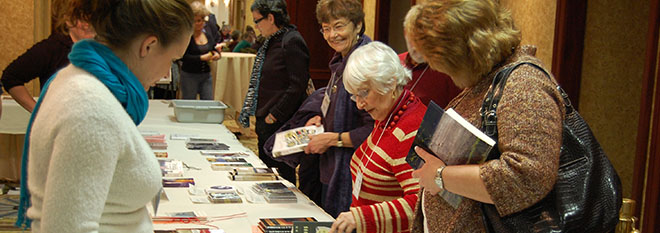This entry is part of Getaway Reads, a weekly e-mail series curated by Stephanie Cawley that features the writing of the Winter Poetry & Prose Getaway faculty.
from Killing the Messenger
by Thomas Peele
Where justice is denied, where poverty is enforced, where ignorance prevails, and where any one class is made to feel that society is an organized conspiracy to oppress, rob, and degrade them, neither persons nor property will be safe.
–Frederick Douglass
Him.
That kid. Over there. In the skullcap. With the iPod.
Him. That motherfucker. Hit him, someone at the other end of the crowded train car whispered, take his shit.
The kid had seen the pack of young guys, nearly howling, push their way on board a station back. He tried to divert his eyes, to ignore them. They looked loaded and out for trouble.
As the kid tried not to watch, Devaughndre Monique Broussard sliced through the crowd toward him, pushing, shoving, closing the distance. He ripped the white earbuds away; his other hand balled into a fist that slashed through the air and spattered the kid’s face. The kid fell, the iPod now Broussard’s. Broussard punched him again. But two mere blows and possession of a four-hundred-dollar music player were not enough to quell his anger and the years of nothingness that kindled it. Broussard kept punching, then started kicking, the kid’s face becoming a lake of blood. Four of Broussard’s friends joined him.
It was Halloween night 2005, a San Francisco tradition of tawdry revelry broken by punches and shouts. The little train, an outbound two-car on the K line, lurched into the Church Street Station, costumed bodies skidding. One of Broussard’s friends grabbed the victim’s wallet and left him curled in a ball and crying, his arms wrapped around his ribs, his face pressed into the dirty, rubberized matting on the floor. The car doors yawned open and Broussard and his cohort poured onto the platform, but not before Broussard spotted a security camera in the train car. He had a red Magic Marker in his pocket and tried to color over the lens, looking right into it as he scribbled, as if his actions could somehow destroy recorded images.
The kid was really a young man, a twenty-year-old art student who somehow got to his feet and took a few staggering steps after them. A cop ran down nearby stairs and, not knowing what had happened—the randomness of it all—handcuffed the bloody young man and hustled him to a nearby bench, thinking him culpable in the violence.
The art student was the nephew of one of San Francisco’s most prominent and savvy politicians. Former supervisor Tony Hall was an anomaly in city politics—a conservative voice in a left-leaning town. Hall opposed abortion and one of San Francisco’s most sacred institutions: rent control. He had many friends on the police force who often fell short of embracing the city’s liberal values. Hall wasn’t going to just let his nephew take a beating from some hooligan.
Between his victim’s uncle and the violence captured on the video camera, Broussard never stood a chance. Police scooped him up off a corner in the Fillmore District two weeks later and charged him with robbery, battery, and assault with a deadly weapon. Broussard pleaded guilty to assault. He could have gone to prison for three years; instead, the judge gave him a year in county jail and probation. Two years later, when Broussard had been released after less than a year and committed a gruesome murder, Hall would climb on a soapbox and rail against the light sentence: “That punk should have never been out on the streets.” Law-and-order types like Hall often seem quick to want to throw away a kid like Broussard with little examination of the circumstances. Broussard deserved time in jail for the beating; it should have been longer. No one, though, deserved a story like his.
————————–
Just weeks before Broussard attacked the art student, police had arrested his mother, Aundra Reniece Dixon, on drug charges. It was nothing new. Dixon had been in and out of prison for all of Broussard’s eighteen years—starting when he was just ten months old in 1988. She struggled against drugs all her adult life, losing often. Broussard, born in San Francisco on October 11, 1987, was her second child. She would eventually have at least four children with four different men. Dixon lost custody of a daughter born in 1985 when she was arrested for drug possession just after her baby turned one. “She has had an anguished life,” a lawyer wrote of her in February 1987. A judge modified Dixon’s sentence so she might try to regain her daughter. Broussard was born eight months later, but Dixon returned to jail on more drug charges before his first birthday. Like his older half sister, Broussard ended up in a foster home until Dixon was released after eighteen months. By then, Broussard had begun to develop a stutter that would plague him into adulthood.
Dixon attended painting and anger-management classes and met a man named Marcus Callaway. They moved in together in the Western Addition, a San Francisco ghetto just blocks from City Hall, its gilded dome modeled after the U.S. Capitol. Dixon soon became pregnant. But the relationship didn’t last, and within a few years she was in prison again, first on more drug charges, then, in 1999, for shooting a woman. Social workers placed Broussard in a program for emotionally disturbed children at a campus of terra-cotta-roofed buildings near the ocean in southwest San Francisco. It was a long way from Richmond, the East Bay city where Marcus Callaway had moved when he and Dixon split. But Callaway was a good-hearted man; he loved Broussard as if he were his own son. Family was family and the child needed someone. So Callaway made the drive as often as he could, leaving his job as a mechanic and junk dealer unfinished and fighting traffic across the Bay Bridge. After a year of struggling with paperwork and other requirements to become a foster parent, Callaway took Broussard, then fourteen years old, home.
Richmond is one of the most hopeless and violent cities in America, an oil-refinery town of 103,000 people, littered with shanties where shipyard workers lived during World War II. Callaway resided in a house on a squalid corner lot behind a chain-link fence at the northern tip of an area called the Iron Triangle, Richmond’s killing zone. Two of his own sons lived with him. So did one of Broussard’s half sisters. And yet, in a neighborhood where gunfire was more common than kids toting backpacks of schoolbooks, Broussard survived. Callaway gave him what he’d never had: slivers of stability and what the youngster craved more than anything else, a person who wasn’t looking through him. Reality for a young African American male in Richmond is measured by two things: If a day ends without his either killing someone or lying naked himself on a slab in the Contra Costa County coroner’s office, it is a success.
But in this new home, Broussard succeeded and even showed that with enough nurturing, he might thrive. Callaway taught him to play chess, and he joined the high school team. The family called him Catfish because of the stray, unruly whiskers that began to sprout from his chin. He pulled a C-minus average at Richmond High School, nearly a miracle considering what he had started. At the end of his sophomore year, one of Broussard’s teachers enrolled him in a summer camp at the University of California, Berkeley’s Haas School of Business. Broussard devised a mock investment portfolio that won him a hundred-dollar savings bond. Those who knew him spoke in hopeful ways. Catfish, they whispered, might make it.
Then Aundra Dixon got out of prison again in 2005 and wanted her son back.
Three years later, Marcus Callaway stood one morning in the yard of his tiny Richmond home. There were two battered Jet Skis on a trailer in a driveway littered with car parts. Just beyond his chain-link fence, a four-inch-long piece of what looked like raw meat sat on the sidewalk, attracting flies. It was flesh and sinew ripped from the flank of a drug dealer’s dog that had encountered another mongrel. Callaway excused himself. He took a rusty shovel, scooped up the carrion, and flung it high through the air and into a stand of weeds across the street. He then went back to talking about Broussard, soon bursting into tears. “He never was out in the streets, I never let him,” he said. “All my kids, I tried to send them to school because I wanted them to be better than I was. I was trying to get him into a university, but then his mom came home and he went to her, and that’s when he got into trouble.”
Across the bay, the joy of a reunion with Dixon had lasted but a few weeks. Broussard and Dixon had moved in with her mother in a shotgun house in San Francisco’s Bayview—Hunters Point neighborhood, a south-end slum not far from Candlestick Park. To finance the household, the two women peddled crack and heroin. Dixon became known around the neighborhood as “Lady D” and offered the house—for a fee—as a place where people could consume the drugs she sold. But the market was saturated. Dixon’s mother suffered from AIDS and needed help. They weren’t making enough money and Dixon told her son to drop out of school and get a job. He took off instead. Dixon called the police and reported Broussard a runaway. Within a week, police in San Mateo County, south of San Francisco, arrested him for robbery and he was placed in juvenile jail.
Around the same time, a social worker was sent to Dixon’s house after someone anonymously reported child abuse. Dixon told the social worker she would follow him home and “fuck him up” if he didn’t leave. He was scared enough that he obtained a restraining order and reported to police that Dixon was running a drug house. The anonymous caller about the child abuse was Broussard. It was his last attempt to save himself.
Police soon kicked down Dixon’s door and found heroin and cocaine. She was released, but police were back again a few months later when a passing officer saw a man smoking crack on the front porch. This time, Dixon returned to prison. Broussard, released from jail, went to the streets, living on and off with a relative on Treasure Island, a former naval base. A few months later, on Halloween night, just after his eighteenth birthday, he saw a kid on a train with an iPod.
© Thomas Peele. Published in Killing the Messenger: A Story of Radical Faith, Racism’s Backlash, and the Assassination of a Journalist, Random House, 2012. This excerpt taken from Chapter 3, “An Anguished Life.”
+ + + + + + + + + +
+ + + + + + + + + +
Want to study with Thomas Peele? At the 2014 Winter Poetry & Prose Getaway, Thomas will be leading the Advanced Creative Noniction Workshop. Click here to find out more.
+ + + + + + + + + +
Advance your craft and energize your writing at the Winter Poetry & Prose Getaway. Enjoy challenging and supportive sessions, insightful feedback and an encouraging community. Learn more.




